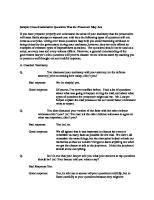1Z0-071 Sample Questions
Oracle 1Z0-071 Oracle Database 12c SQL Download Full Version : http://killexams.com/pass4sure/exam-detail/1Z0-071 Q
Views 199 Downloads 9 File size 2MB
Recommend stories
- Author / Uploaded
- madhuban
Citation preview
Oracle
1Z0-071
Oracle Database 12c SQL
Download Full Version : http://killexams.com/pass4sure/exam-detail/1Z0-071
QUESTION: 64 Which task can be performed by using a single Data Manipulation Language (OML) statement?
A. adding a column constraint when inserting a row into a table B. adding a column with a default value when inserting a row into a table C. removing all data only from one single column on which a unique constraint is defined D. removing all data only from one single column on which a primary key constraint is defined
Answer: D
QUESTION: 65 Which statements are true regarding the WHERE and HAVING clauses in a SELECT statement? (Choose all that apply.)
A. The HAVING clause can be used with aggregate functions in subqueries. B. The WHERE clause can be used to exclude rows after dividing them into groups. C. The WHERE clause can be used to exclude rows before dividing them into groups. D. The aggregate functions and columns used in the HAVING clause must be specified in the SELECT list of the query. E. The WHERE and HAVING clauses can be used in the same statement only if they are applied to different columns in the table.
Answer: A, C
QUESTION: 66
Which statement is true regarding the INTERSECT operator?
A. It ignores NULL values B. The number of columns and data types must be identical for all SELECT statements in the query C. The names of columns in all SELECT statements must be identical D. Reversing the order of the intersected tables the result
Answer: B
Explanation: INTERSECT Returns only the rows that occur in both queries’ result sets, sorting them and removing duplicates. The columns in the queries that make up a compound query can have different names, but the output result set will use the names of the columns in the first query.
QUESTION: 67 View the Exhibit and examine the ORDERS table. The ORDERS table contains data and all orders have been assigned a customer ID. Which statement would add a NOT NULL constraint to the CUSTOMER_ID column?
A. ALTER TABLE orders
ADD CONSTRAINT orders_cust_id_nn NOT NULL (customer_id);
B. ALTER TABLE orders
MODIFY customer_id CONSTRAINT orders_cust_id_nn NOT NULL;
C. ALTER TABLE orders
MODIFY CONSTRAINT orders_cust_id_nn NOT NULL (customer_id);
D. ALTER TABLE orders
ADD customer_id NUMBER(6)CONSTRAINT orders_cust_id_nn NOT NULL;
Answer: B
QUESTION: 68
Examine thestructure of the BOOKS_TRANSACTIONS table:
You want to display the member IDs, due date, and late fee as $2 for all transactions. Which SQL statement must you execute?
A) Exhibit
B) Exhibit
C) Exhibit
D) Exhibit
A. Option A B. Option B C. Option C D. Option D
Answer: C
QUESTION: 69 View the Exhibit and examine the structure of ORDERS and ORDER_ITEMS tables. ORDER ID is the primary key in the ORDERS table. It is also the foreign key in the ORDER_ITEMS table wherein it is created with the ON DELETE CASCADE option.
Which DELETE statement would execute successfully?
A. DELETE order_id FROM orders
WHERE order_total < 1000;
B. DELETE orders
WHERE order_total < 1000;
C. DELETE FROM orders
WHERE (SELECT order_id FROM order_items);
D. DELETE orders o, order_items i WHERE o.order id = i.order id;
Answer: B
QUESTION: 70 You want to display 5 percent of the rows from the sales table for products with the lowestAMOUNT_SOLD and also want to include the rows that have the sameAMOUNT_SOLDeven if this causes the output to exceed 5 percent of the rows. Which query willprovide the required result?
A. SELECT prod_id, cust_id, amount_sold FROM sales ORDER BY amount_sold FETCH FIRST 5 PERCENT ROWS WITH TIES; B. SELECT prod_id, cust_id, amount_sold FROM sales ORDER BY amount_sold FETCH FIRST 5 PERCENT ROWS ONLY WITH TIES; C. SELECT prod_ id, cust_id, amount_sold FROM sales ORDER BY araount_sold FETCH FIRST 5 PERCENT ROWS WITH TIES ONLY; D. SELECT prod_id, cust_id, amount_sold FROM sales ORDER BY amount sold FETCH FIRST 5 PERCENT ROWS ONLY;
Answer: B
QUESTION: 71
The following are the steps for a correlated subquery, listed in random order:
1) The WHERE clause of the outer query is evaluated.
2) The candidate row is fetched from the table specified in the outer query.
3) The procedure is repeated for the subsequent rows of the table, till all the rows
are processed.
4) Rows are returned by the inner query, after being evaluated with the value from
the candidate row in the outer query. Identify the option that contains the steps in
the correct sequence in which the Oracle server evaluates a correlated subquery.
A. 4,2,1,3 B. 4,1,2,3 C. 2,4,1,3 D. 2,1,4,3
Answer: C
QUESTION: 72
Which statement correctly grants a system privilege?
A. GRANT EXECUTE ON prod TO PUBLIC; B. GRANT CREATE VIEW ON tablel TO used; C. GRANT CREATE TABLE TO used ,user2; D. GRANT CREATE SESSION TO ALL;
Answer: C
QUESTION: 73
View the Exhibit and examine the data in ORDERS and ORDER_ITEMS tables.
You need to create a view that displays the ORDER ID, ORDER_DATE, and the
total number of items in each order.
Which CREATE VIEW statement would create the view successfully?
A. CREATE OR REPLACE VIEW ord_vu (order_id,order_date) AS SELECT
o.order_id, o.order_date, COUNT(i.line_item_id) "NO OF ITEMS"
FROM orders o JOIN order_items i ON (o.order_id = i.order_id)
GROUP BY o.order_id,o.order_date;
B. CREATE OR REPLACE VIEW ord_vu
AS SELECT o.order_id, o.order_date, COUNT(i.line_item_id) "NO OF ITEMS"
FROM orders o JOIN order_items i ON (o.order_id = i.order_id)
GROUP BY o.order_id,o.order_date;
C. CREATE OR REPLACE VIEW ord_vu
AS SELECT o.order_id, o.order_date, COUNT(i.line_item_id) FROM orders o
JOIN order_items i ON (o.order_id = i.order_id) GROUP BY
o.order_id,o.order_date;
D. CREATE OR REPLACE VIEW ord_vu
AS SELECT o.order_id, o.order_date, COUNT(i.line_item_id)ll’ NO OF ITEMS' FROM orders o JOIN order_items i ON (o.order_id = i.order_id) GROUP BY o.order_id,o.order_date WITH CHECK OPTION;
Answer: B
For More exams visit http://killexams.com
Kill your exam at First Attempt....Guaranteed!









